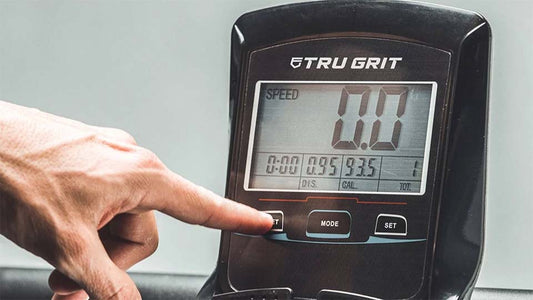High-Intensity Interval Training Treadmill: Programs, Benefits & Recovery Tips
Unlock the power of treadmill HIIT in just 15 – 25 minutes. This science-backed guide delivers three level-specific programs, a 5-minute warm-up, sauna recovery hacks, and a downloadable 30-day calendar. Burn more calories in half the time, boost VO₂-max, and train smarter with gear picks from My Fitness Outlet.

Quick Takeaways
Need the gist of a high-intensity interval training treadmill workout? Skim these highlights and get moving faster.
- 15–25 minutes of treadmill HIIT can drive VO2-max improvements comparable to a 40-minute steady run.
- 300–500 calories burned in 30 minutes for a 160-lb runner, depending on speed and incline.
- Cap it with a 15-minute sauna session to boost plasma volume (~7 %) and cut recovery time.
- Tap or copy the printable workout card below for instant treadmill settings.
What Is HIIT—And Why Use a Treadmill?
Definition & Energy Systems
High-intensity interval training (HIIT) alternates near-maximal bursts (≈85–95 % HRmax) with low-intensity recovery bouts. The sprints rely on anaerobic phosphagen and glycolytic pathways, while the recoveries tap back into the aerobic system—this mixed-fuel demand is the reason HIIT boosts VO2 max faster than steady cardio. Sessions stay short (15–25 min) yet drive mitochondrial biogenesis, insulin sensitivity, and cardiovascular efficiency.
Treadmill Advantages
- Precision control: Dial exact speed & incline for repeatable overload—something a track or road can’t match on windy days.
- Built-in feedback: Most units display heart-rate or pair with straps (benefits of heart-rate monitors) for data-driven progression.
- Weather-proof & space-efficient: Train year-round and, with folding decks, even in apartments (best treadmills for small spaces).
- Safer deceleration: Emergency-stop clips and the moving belt let you step to the rails instantly—cutting injury risk vs outdoor sprints
Science-Backed Benefits of Treadmill HIIT
Just 15–25 minutes of high-intensity bursts sandwiched between brief recoveries creates a powerful metabolic wave. Research reports 6–15 % VO2-max gains in four weeks, sharper insulin sensitivity, greater fat oxidation, and higher BDNF for mood and cognition. The short, repeated stress also sparks mitochondrial biogenesis, giving each muscle cell more “engines” to burn fuel.
Explore the primary literature on PubMed, or read Harvard’s clinical summary for practical context.
Safety Checklist & 5-Minute Warm-Up
Pre-Workout Safety Checklist
- Dynamic mobility first: prime hips, knees, and ankles before touching the belt.
- Gradual ramp: target ≤ 60 % HRmax during the warm-up to ready the cardiovascular system.
- Footwear & emergency-stop: lace supportive shoes and clip the safety key so you can halt instantly.
- Contraindications: seek medical clearance if pregnant, hypertensive, or managing cardiac conditions.
5-Minute Dynamic Warm-Up
- 20 × front-to-back leg swings per leg.
- 15 × side-to-side leg swings per leg.
- 20 hip circles clockwise, then 20 counter-clockwise.
- Walk 1 minute at 2–3 mph to elevate heart rate.
- Jog 2 minutes, gradually increasing pace until you reach ~60 % HRmax.
3-Tier HIIT Treadmill Programs
Choose the tier that fits your current conditioning—then level-up every 4 weeks. Each program lasts 15–25 minutes from the first sprint to the end of the active recovery. Tap the “Copy” link to snag the settings for your notes app or fitness tracker.
Beginner — 15-Minute “Build & Burn”
| Interval | Speed (mph) | Incline (%) | Duration | HR Zone |
|---|---|---|---|---|
| Sprint ×5 | 6.0–7.0 | 1 | 30 s | RPE 8 |
| Walk recovery | 3.0 | 0 | 60 s | RPE 2 |
Intermediate — 20-Minute “Incline Inferno”
| Interval | Speed (mph) | Incline (%) | Duration | HR Zone |
|---|---|---|---|---|
| Sprint ×6 | 7.5–8.5 | 6 | 40 s | RPE 8–9 |
| Jog recovery | 4.0 | 1 | 60 s | RPE 3 |
Advanced — 25-Minute “Sprint Surge”
| Interval | Speed (mph) | Incline (%) | Duration | HR Zone |
|---|---|---|---|---|
| Sprint ×8 | 9.0+ | 2 | 45 s | RPE 9 |
| Jog recovery | 4.5 | 0 | 45 s | RPE 3 |
| Optional finisher | 8.0 | 8 | 60 s | RPE 9+ |
Cool-Down & Post-Workout Recovery
5-Minute Walk & Static Stretch
Drop your speed to 2–3 mph and walk for 3 minutes to flush out lactate, then step off and spend 2 minutes on static stretches: standing quad hold, hamstring reach, and calf wall stretch—20 seconds per side. This gradual taper lets HR and core temperature normalize while preserving ankle mobility for your next session.
Sauna / Heat-Therapy Add-On
If you have access, sit in a dry sauna at ≈ 175 °F (80 °C) for 15 minutes. The passive heat bolsters blood flow, expands plasma volume, and can trim delayed-onset muscle soreness (DOMS) by up to 30 %. For a deeper dive into the mechanisms and safety tips, bookmark our Complete Sauna Benefits Guide.
Hydration & Electrolytes Checklist
- 16–20 oz water within 30 min post-workout.
- 400–600 mg sodium and 100–200 mg potassium (sports drink, coconut water, or salt tab).
- Optional: 3–5 g creatine and 20–30 g protein if training fasted.
Periodization: Fitting HIIT Into Your Week
Treat HIIT like strength work—quality over quantity. Slot in 2–3 non-consecutive sessions per week to let muscles and the nervous system rebound. Complement those sprints with steady-state cardio, two full-body strength blocks, and at least one low-impact mobility practice (yoga or dynamic stretching) for joint longevity.
- Mon: Steady 30-min run + core
- Tue: HIIT treadmill (Beginner/Int/Adv)
- Wed: Strength day
- Thu: Mobility / active recovery
- Fri: HIIT treadmill
- Sat: Strength + optional sauna
- Sun: Rest
Every 4th week = deload: trim interval count or speed by ≈40 % to consolidate gains and dodge overtraining, a strategy echoed by the ACSM.
Common Mistakes & Form Tips
Frequent Missteps
- Gripping or leaning on the handrails—kills posture and reduces workload.
- Skipping the warm-up and hitting max speed cold.
- Cranking incline too high too soon—invites calf and Achilles strain.
Running-Form Cue Checklist
- Mid-foot landing under hips—avoids braking forces.
- Relaxed shoulders and slight forward lean from ankles.
- Arms at 90°, drive back not across the body.
Frequently Asked Questions
Is 20 minutes of treadmill HIIT enough?
Absolutely—provided your intervals hit 85–95 % of your maximum heart rate. A 20-minute protocol with a 5-minute warm-up, 10 minutes of work:rest cycles, and a brief cool-down can raise VO₂-max and insulin sensitivity as effectively as a much longer steady run.
How many calories can I burn?
A 160-lb (73 kg) runner typically expends 300–500 calories in a 30-minute HIIT session. Factors include interval intensity, belt incline, running economy, and after-burn (EPOC), which can tack on another 6–15 % over the next few hours.
HIIT vs steady-state—what’s better for fat loss?
Both work; HIIT is time-efficient and preserves lean mass thanks to its hormonal response, while steady-state burns more total calories per bout and aids recovery. A balanced week usually blends 2–3 HIIT bouts with one longer low-intensity run or cycle.
Can beginners do HIIT every day?
No—muscles, tendons, and the nervous system need 48 hours to adapt. Start with two non-consecutive sessions a week, keep RPE at 7–8, and add volume only after four consistent weeks without lingering soreness.
Should I use a sauna right after HIIT?
Yes, if you’re healthy and hydrated. A 15-minute dry sauna at ~175 °F can boost blood-flow and speed glycogen replenishment, but drink at least 16 oz electrolyte water first. Full details live in our Complete Sauna Benefits Guide.
Take the Next Step — Your 30-Day Challenge
Ready to turn knowledge into results? Commit to our 30-Day Treadmill HIIT Challenge. Download the printable calendar, drop the workouts straight into Google Calendar, and track each session—plus built-in sauna recovery days. Need gear? Check out the curated treadmills, heart-rate monitors, and infrared saunas at My Fitness Outlet. Your fitter self is 30 days away—let’s go!








